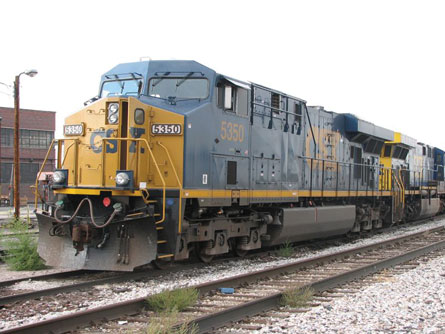Module 3—Effects of Force on Velocity
Lesson 3—Normal Force and Friction
 Get Focused
Get Focused

cc Peter Borcherd
In 2006, Canadian National Railways took delivery of 35 new locomotives produced by General Electric. The locomotive pictured here is from GE’s new Evolution Series Transportation System of new diesel locomotives that meet the environmental standards that took effect in 2005. The ES44DC (Evolution Series 4400-hp DC transmission) uses a 12-cylinder engine that delivers the equivalent power of an older 16-cylinder engine while consuming less fuel and producing fewer emissions. The energy from the 12-cylinder diesel engine is converted into direct current, which powers the electric motors that turn the wheels.
This particular locomotive generates 4400 horsepower! Most of this power is needed when the train is accelerating forward. When it is moving at a constant speed, much less power is needed. Exactly how much power is needed depends on several factors, including the mass of the train, the desired acceleration, any incline in the tracks, and the friction that opposes the motion of the train. More friction leads to less efficiency and more power consumption. One of the advantages of rail transportation is the ability to travel on low-friction surfaces, like steel tracks. Why is this? How do you determine the amount of friction to overcome in a moving system like that of the railway?
In this lesson you will have a brief introduction to free-body diagrams and explore the nature of the normal force and its relationship to weight. You will also graphically determine an expression for kinetic friction and calculate kinetic, static, and rolling friction in a variety of situations.
As you work through this lesson, keep the following questions in mind:
- How does friction affect moving objects?
- How does friction affect making an object move?
- How do free-body diagrams, vector analyses, and Newton’s second law help solve moving-object problems?
 Module 3: Lesson 3 Assignments
Module 3: Lesson 3 Assignments
Your teacher-marked Module 3: Lesson 3 Assignment requires you to submit a response to the following:
- Lab—LAB 1, LAB 2, LAB 3, LAB 4, and LAB 5
- Try This—TR 4 and TR 5
- Reflect and Connect
You must decide what to do with the questions that are not marked by the teacher.
Remember that these questions provide you with the practice and feedback that you need to successfully complete this course. You should respond to all the questions and place those answers in your course folder.